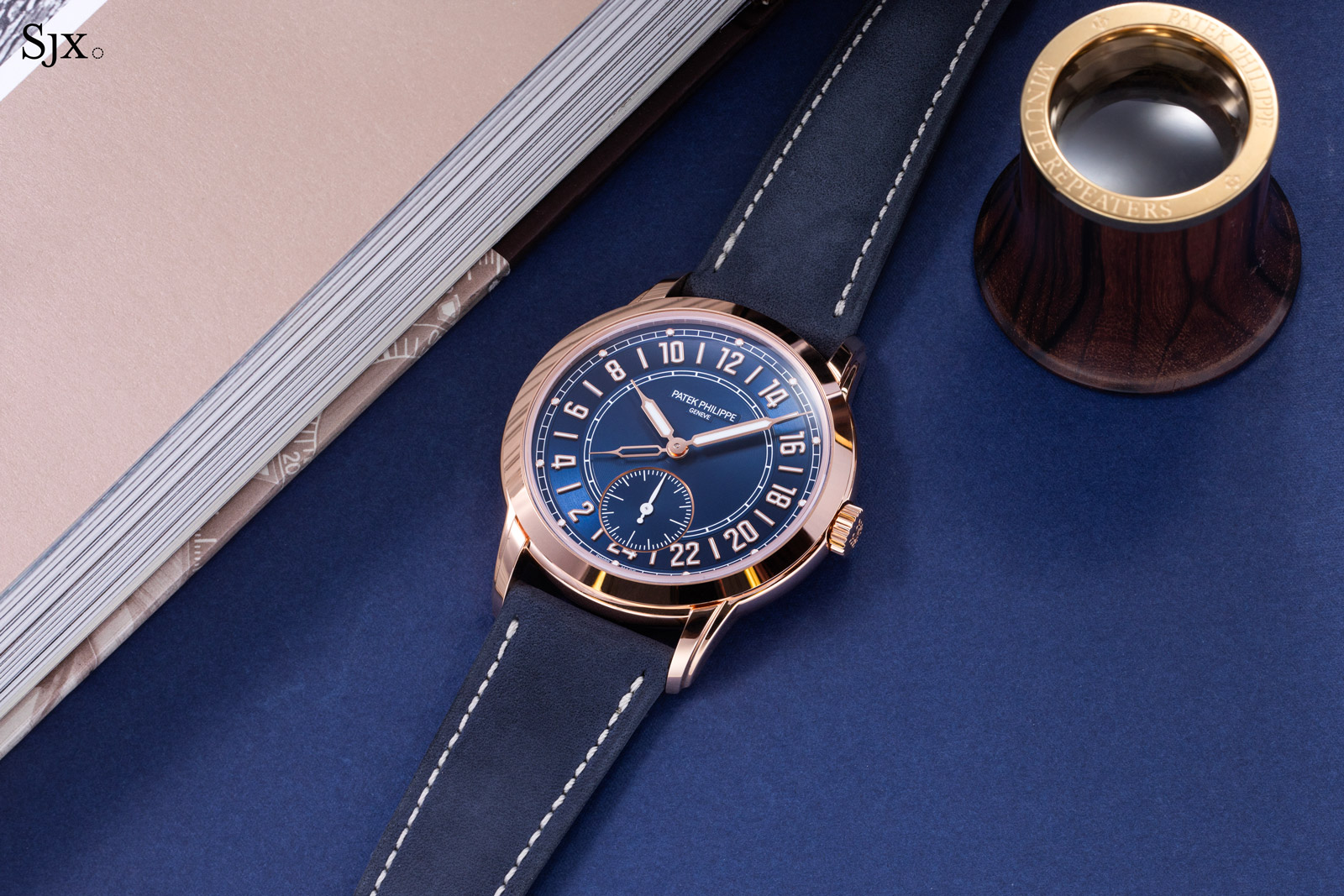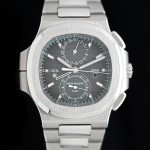Because it has a strongly defined identity and direction, Patek Philippe rarely surprises. The limited editions created for the recent Watch Art Grand Exhibition in Tokyo, for instance, were interesting and occasionally exceptionally complicated but predictable. However, Patek Philippe did surprise, albeit subtly, at Watches & Wonders earlier this year with the Calatrava 24-Hour Display Travel Time Ref. 5224R.
Though the ref. 5224R is typical Patek Philippe in every aspect, from the slim case to the vintage-meets-modern design, it is distinctly different from the brand’s other offerings in both look and feel. Besides the 24-hour dial, a first for the brand in the modern day, the 42 mm case is also oversized by Patek Philippe standards. Despite being novel amongst current Patek Philippe offerings, the ref. 5224R is rooted in the brand’s history, being almost a direct descendent of the 24-hour-dial Chronometro Gondolo pocket watches of the early 20th century.
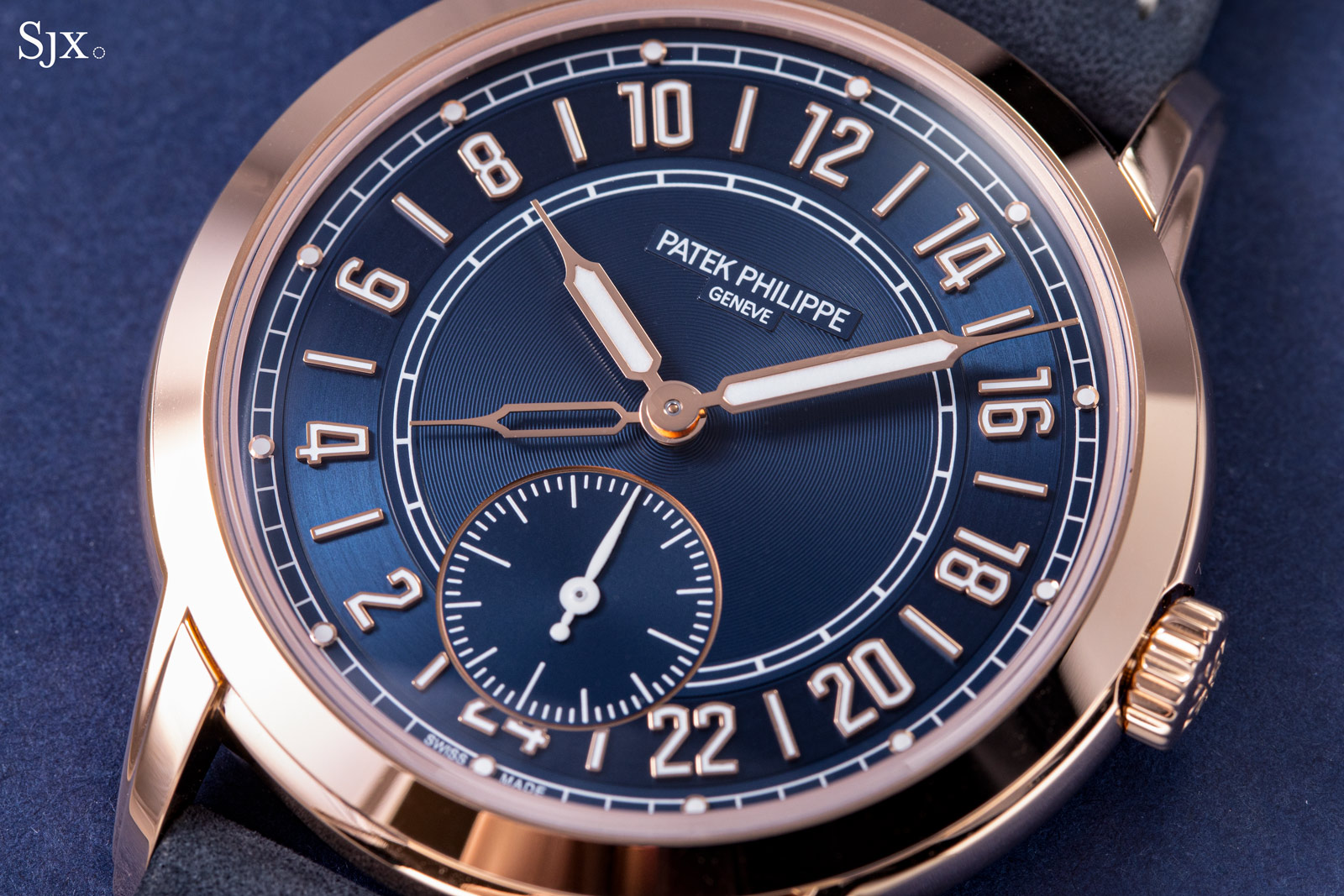
Initial thoughts
The ref. 5224R was instantly appealing when I saw it at Watches & Wonders. It is a large watch, but still elegant. And despite being a relatively simple watch – it’s essentially a two-time zone watch – the ref. 5224R has several interesting features both in terms of design and mechanics.
The most obvious is the 24-hour dial. At a glance, it’s a peculiar feature for a modern Patek Philippe wristwatch, but it looks good and actually makes sense. Though it takes some getting used to when reading the time, the 24-hour display is a logical refinement of the Travel Time complication since it eliminates the day-night indicator, resulting in a clean dial. It also gives the dial a functional, instrument-like appearance that is balanced by high-end execution that includes applied gold numerals.
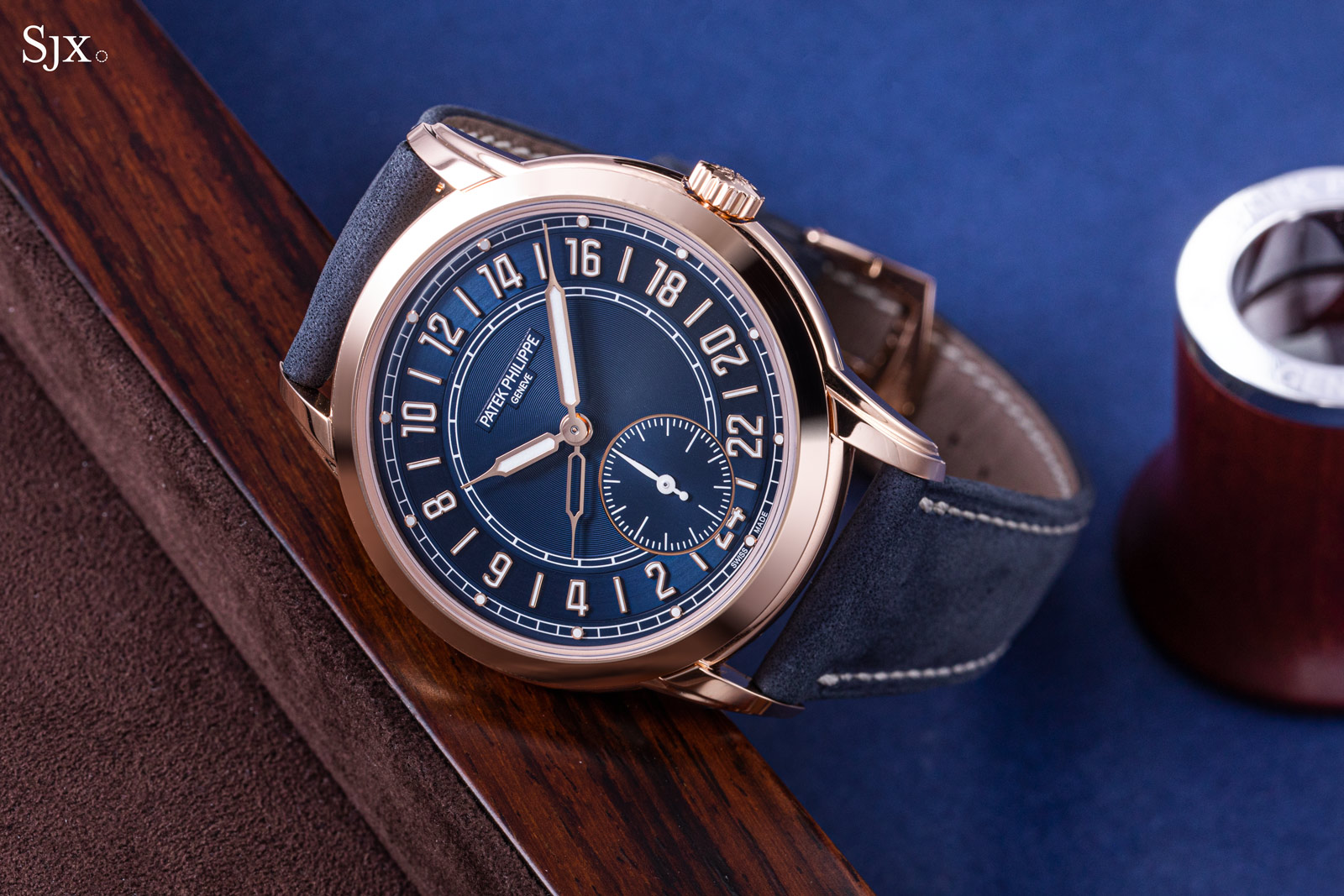
At 42 mm, the ref. 5224R is significantly larger than the average Patek Philippe. In fact, the case is the same diameter as the ref. 5208 Grand Complication. The size is easily apparent on the wrist, but it doesn’t feel chunky because it is slim at under 10 mm high. As a result, it doesn’t lose the elegant profile typical of the brand, which is thanks to both the thinness as well as design of the case.
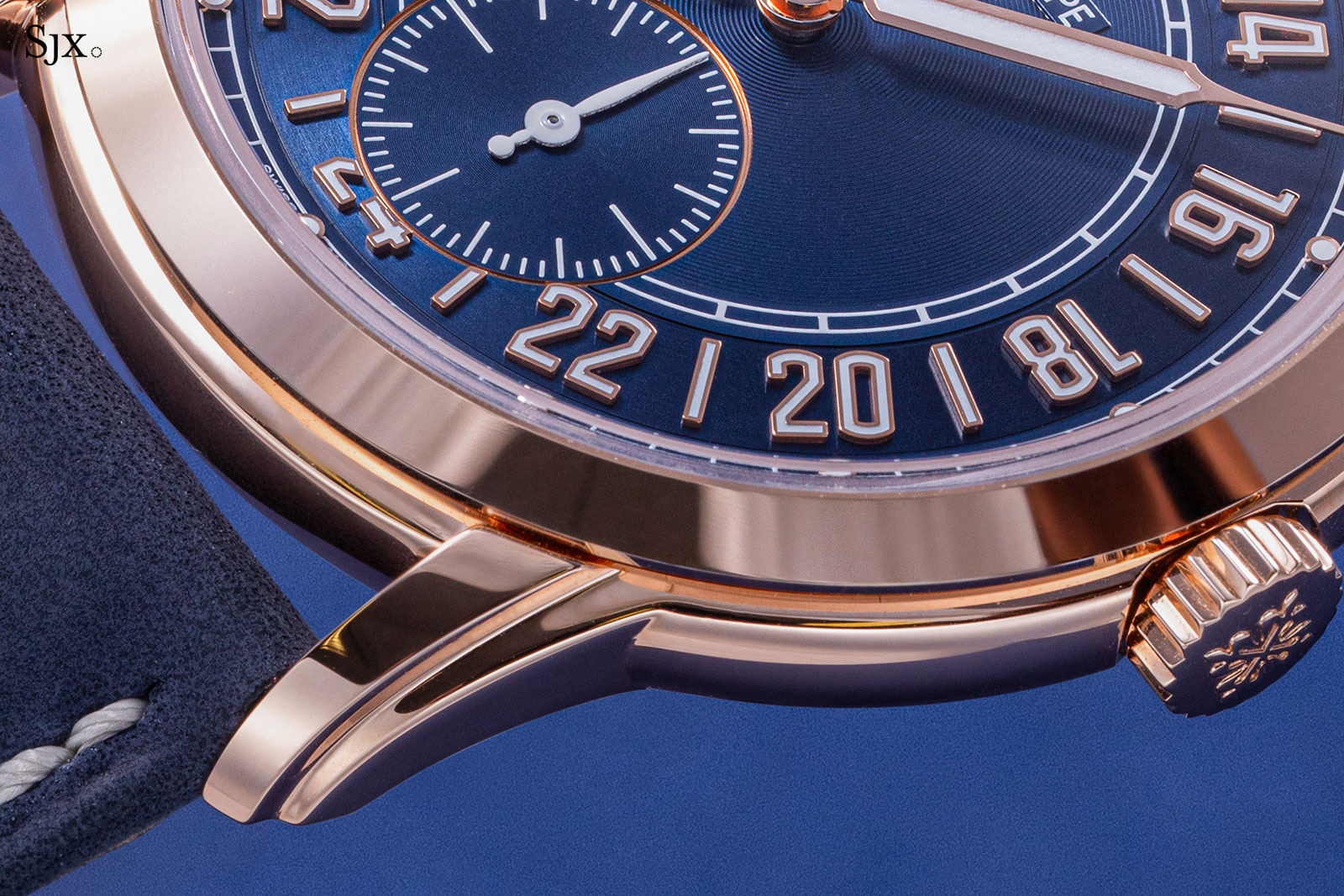
The size of the case is not merely vanity, but because of the cal. 31-260 PS FUH 24H inside. It’s a wide-but-thin movement that’s one of Patek Philippe’s more recent constructions and derived from the movement found in the ref. 5236P In-Line Perpetual Calendar. Compared to the older calibres found in similarly priced models, the cal. 31-260 PS FUH 24H is more refined in both mechanics and aesthetics, which makes the ref. 5224R more appealing from a technical standpoint relative to its peers in the Patek Philippe catalogue.
Interestingly, the Travel Time function has also been upgraded over earlier generations of the complication. It is conveniently adjusted via the crown – pulling the crown to the second position moves the second time-zone hand back and forth – leaving the case free of any pushers or buttons.
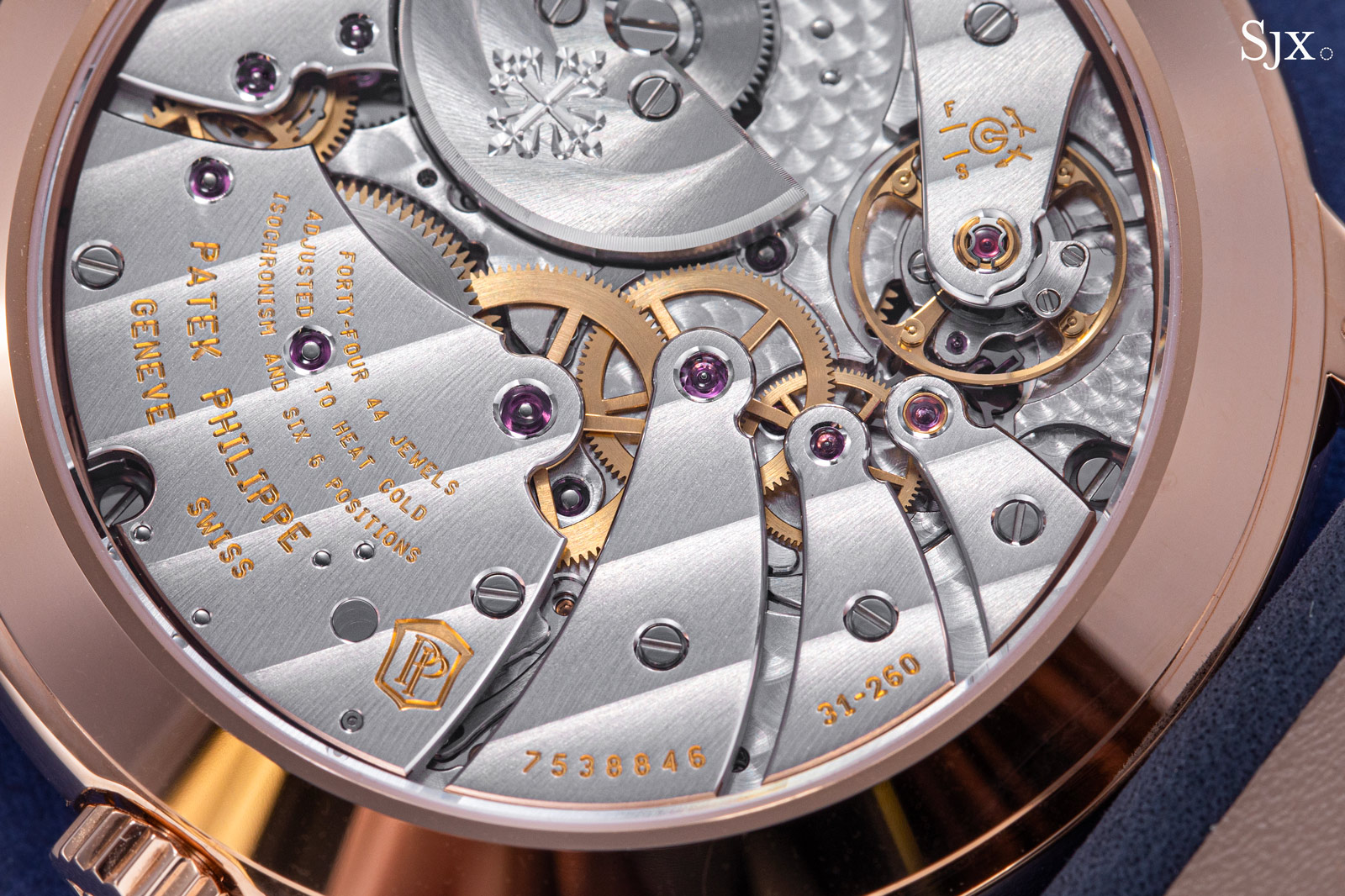
But because of the loud colours, the ref. 5224R is hard to miss. This is only part of the design I would change, as the rose gold case and blue dial has too much contrast, especially when paired with the large case. I would prefer a more restrained combination; white gold and blue, for instance, is easy to execute.
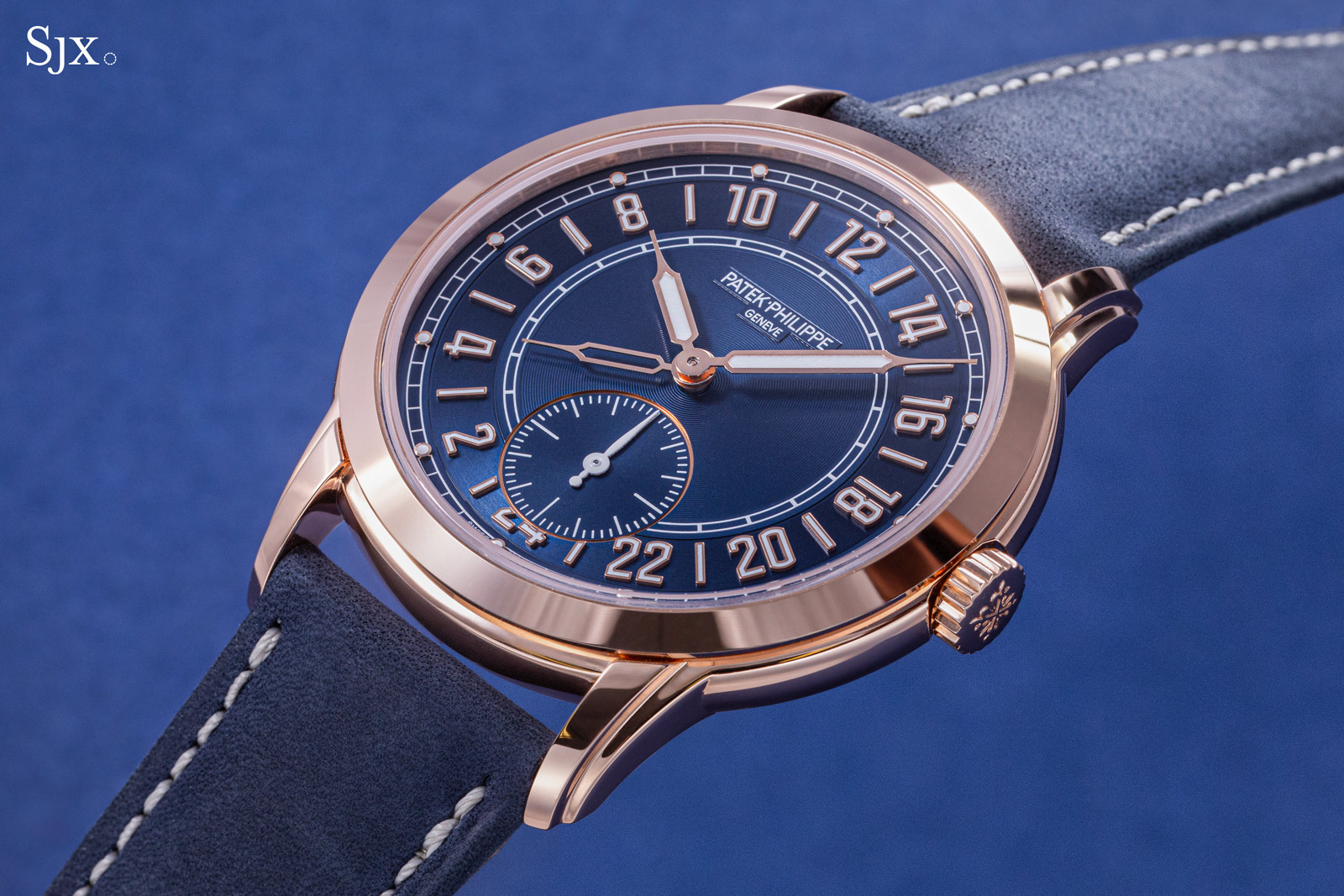
The ref. 5224R costs US$57,370, putting it on par with Patek Philippe’s annual calendar and Travel Time models. It does, however, have a newer and more sophisticated movement, which arguably makes it a better buy. The high-end base movement also justifies the retail price somewhat.
That said, it is pricey for a dual time-zone watch (the 24-hour display is not exactly a complication). Still, the ref. 5224R is a compelling watch, maybe even the most interesting watch in the brand’s catalogue in this price range, because it is attractive, different, yet very much Patek Philippe.
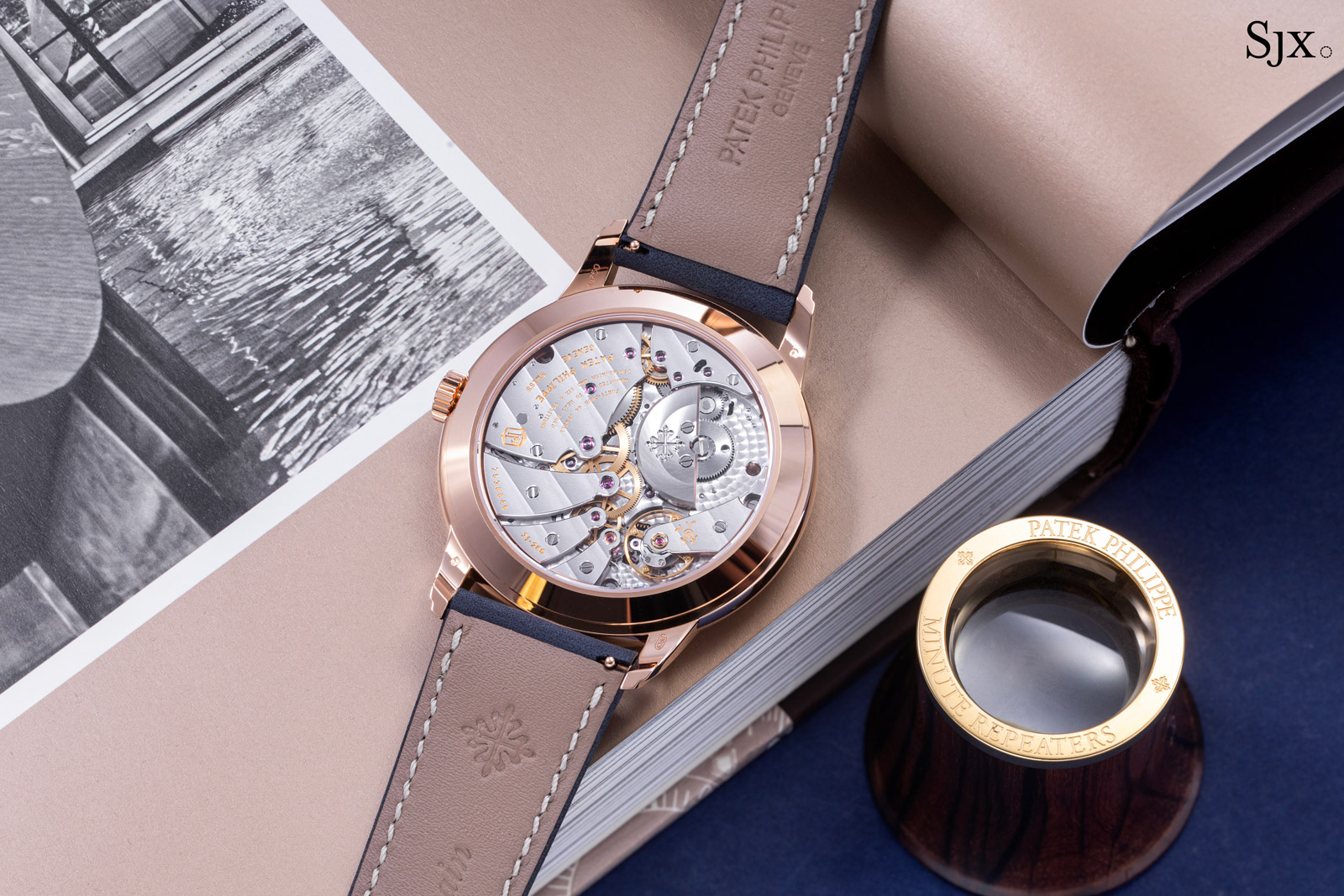
The big and thin cal. 31-260 PS FUH 24H
Descended from the Gondolo
The novel design of the ref. 5224R originates with the Chronometro Gondolo pocket watches Patek Philippe produced in the early 20th century. These got their name from Gondolo & Labouriau, a retailer based in Rio de Janeiro that represented the brand from 1872 and 1927. The Brazilian retailer rode the wave of prosperity that emerged out of the commodities boom that started in the late 19th century. As Brazil profited from its exports of rubber and coffee, so did Gondolo & Labouriau.
Gondolo & Labouriau did well enough that it “retailed close to a third of the entire production of Patek Philippe watches” according to Patek Philippe itself. Unsurprisingly, Patek Philippe produced watches especially for the store known as Chronometro Gondolo, which were originally pocket watches before progressing to wristwatches in the 1920s.
The Chronometro Gondolo watches were distinguished by 9k gold wheels for the going train as well as a “moustache” lever in the escapement. They were available in several different sizes from 10”’ to 22”’, but perhaps the archetypal Chronometro Gondolo pocket watch is the oversized version with a 24-hour dial featuring a single row of Arabic hour numerals with the quarter numerals in red. It is this very style of dial that gave birth of the ref. 5224R.
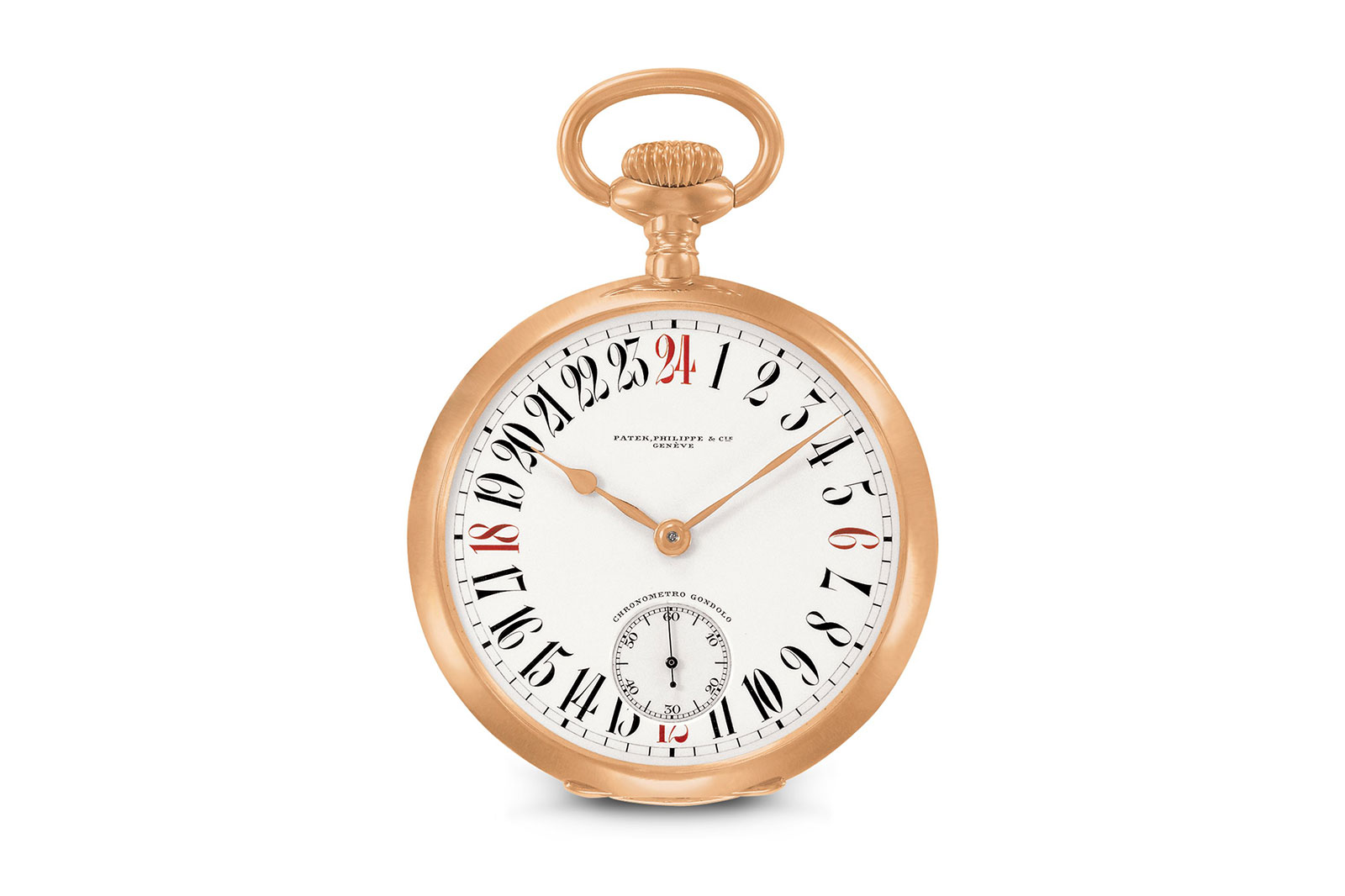
A typical Chronometro Gondolo with a 24-hour dial, this one from 1905 that’s in the Patek Philippe Museum. Image – Patek Philippe
The ref. 5224R modernises the 24-hour display of the Chronometro Gondolo in both style and function. To start with the 12 o’clock position is occupied by, well, “12” on the ref. 5224R, instead of the “24” on historical dials. According to Patek Philippe, this change was implemented for legibility since it is more intuitive to have midday at 12 o’clock – and its designers were certainly right.
The design of the 24-hour scale is clearly contemporary and made interesting with good detailing. Arabic numerals alternate with baton indices along the hour track, ensuring the dial is not too crowded. As a result, the density of the hour numerals is just right. And instead of the classical typography Patek Philippe often employs for Arabic numerals, the ref. 5224R uses an unusual font that I don’t instantly recognise (but if you do, please reach out) but fits the design perfectly.
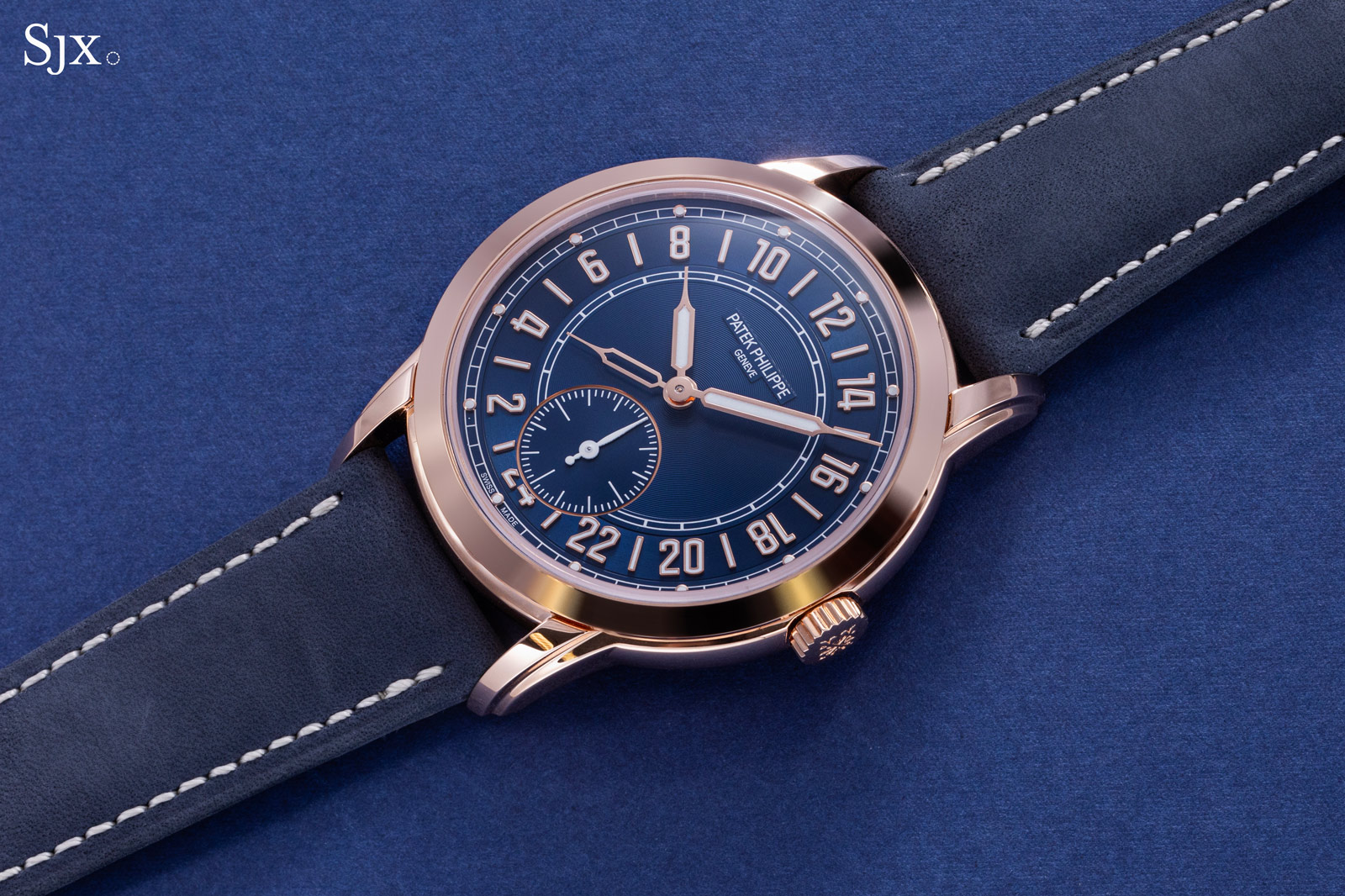
Other noteworthy details include the double railway tracks that help to fill up the large dial. The edge of the dial has a minute track featuring applied dots for the five-minute markers, while the inner circumference has another railway track for the hours. These dual tracks also serve to give the dial an instrument-like feel that suits the 24-hour display.
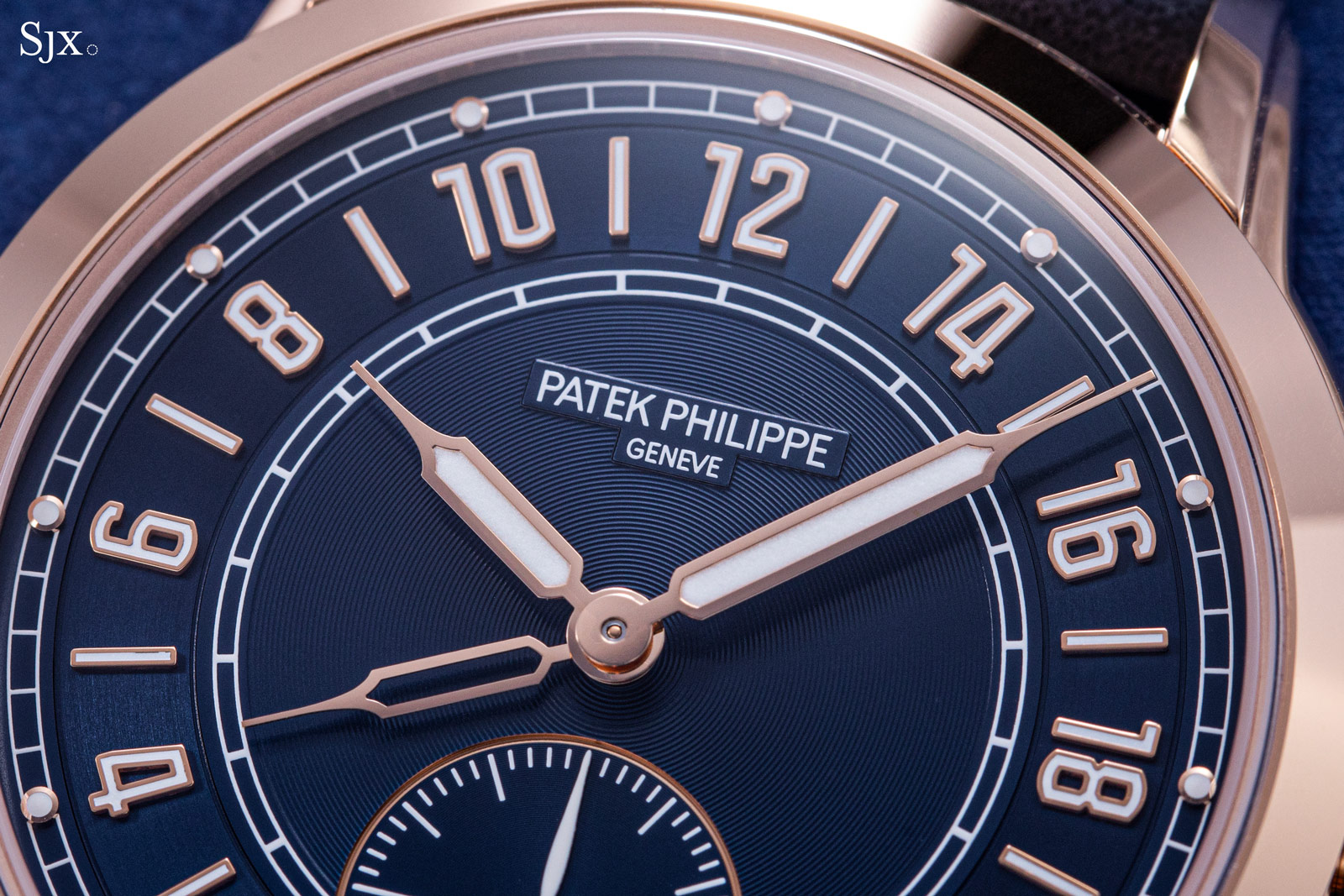
Time is indicated with syringe-style hands
In terms of execution, the dial reflects the advancements Patek Philippe has made in the finish and decoration of its dials. Rather than being artisanal, the dial is probably the work of advanced equipment and some hand finishing, but it is done very well.
While the layout is simple, the dial has a multi-part construction that furthers its visual detail. The centre most portion is stamped with a fine, concentric guilloche, while the seconds register is a separate disc that is slightly recessed below the main dial, and finished with even finer concentric stamping. And then the chapter ring for the hours is a separate ring finished with concentric brushing.
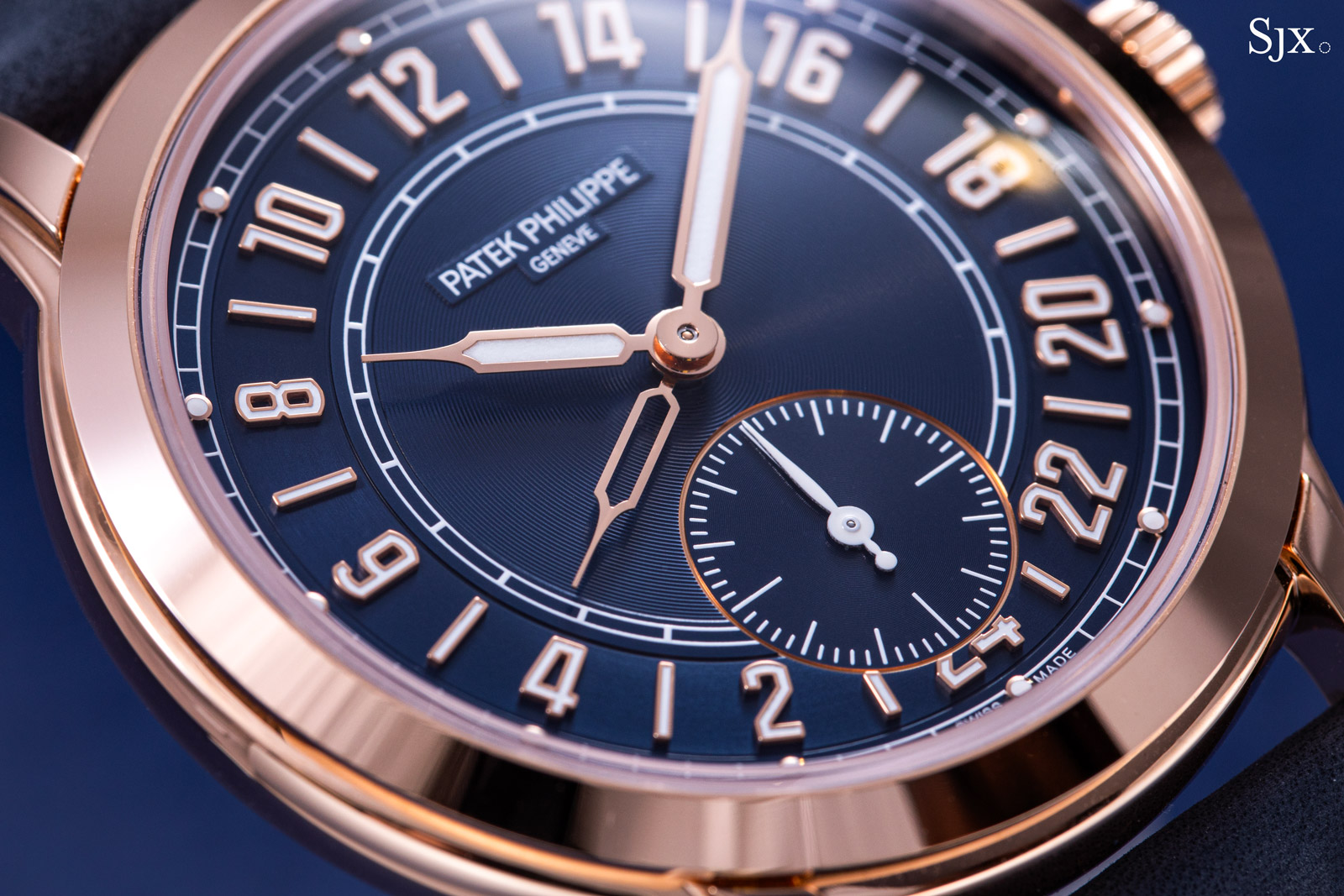
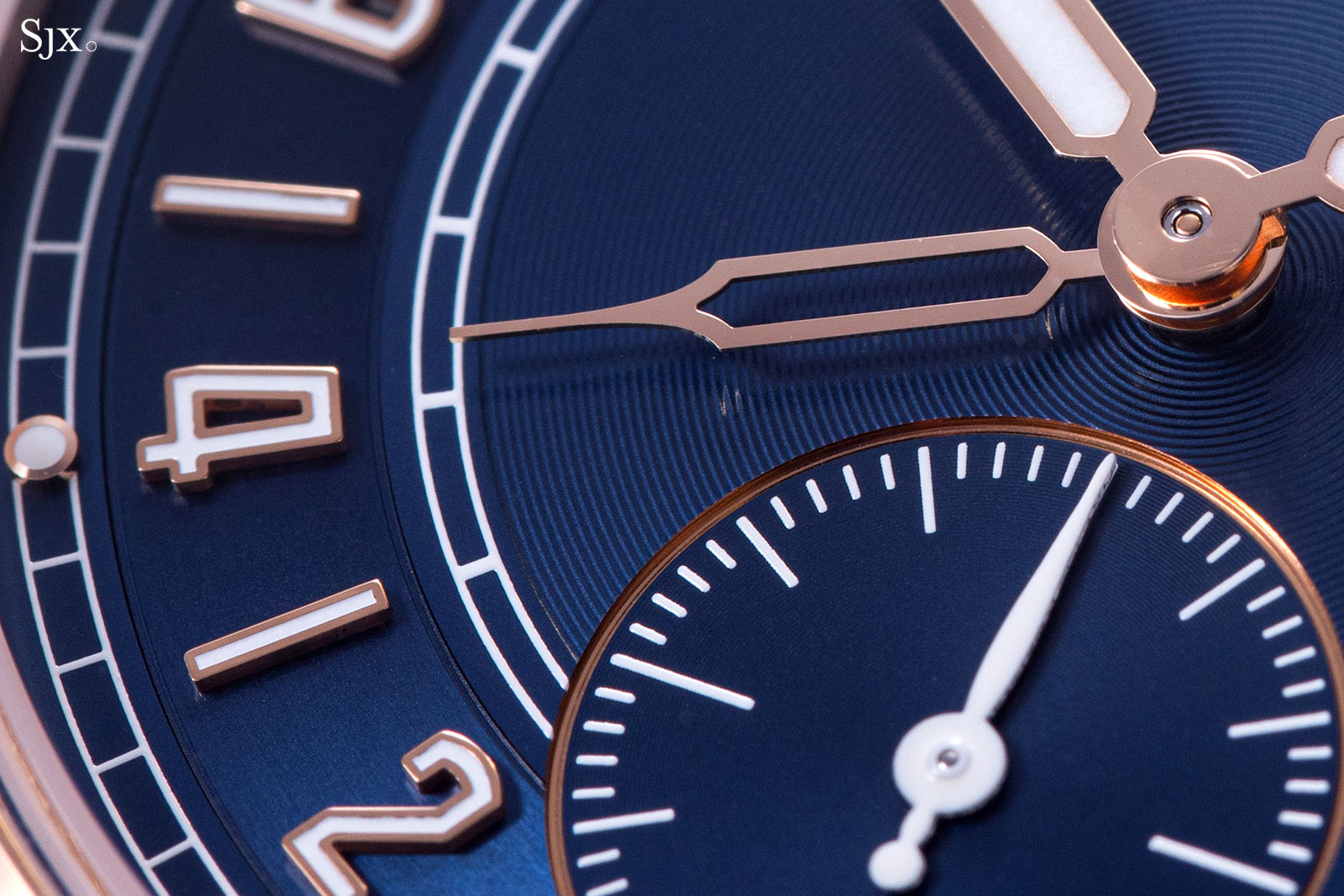
Like many current Patek Philippe watches, the ref. 5224R has hour markers and hands that are 18k solid gold. The syringe-style hands are a good match for the dial and can be found on other models. The hour markers, however, feel taller and more substantial than those in comparable watches like the ref. 5226G. As a result, they give the dial a weight that adds to the presence of the watch.
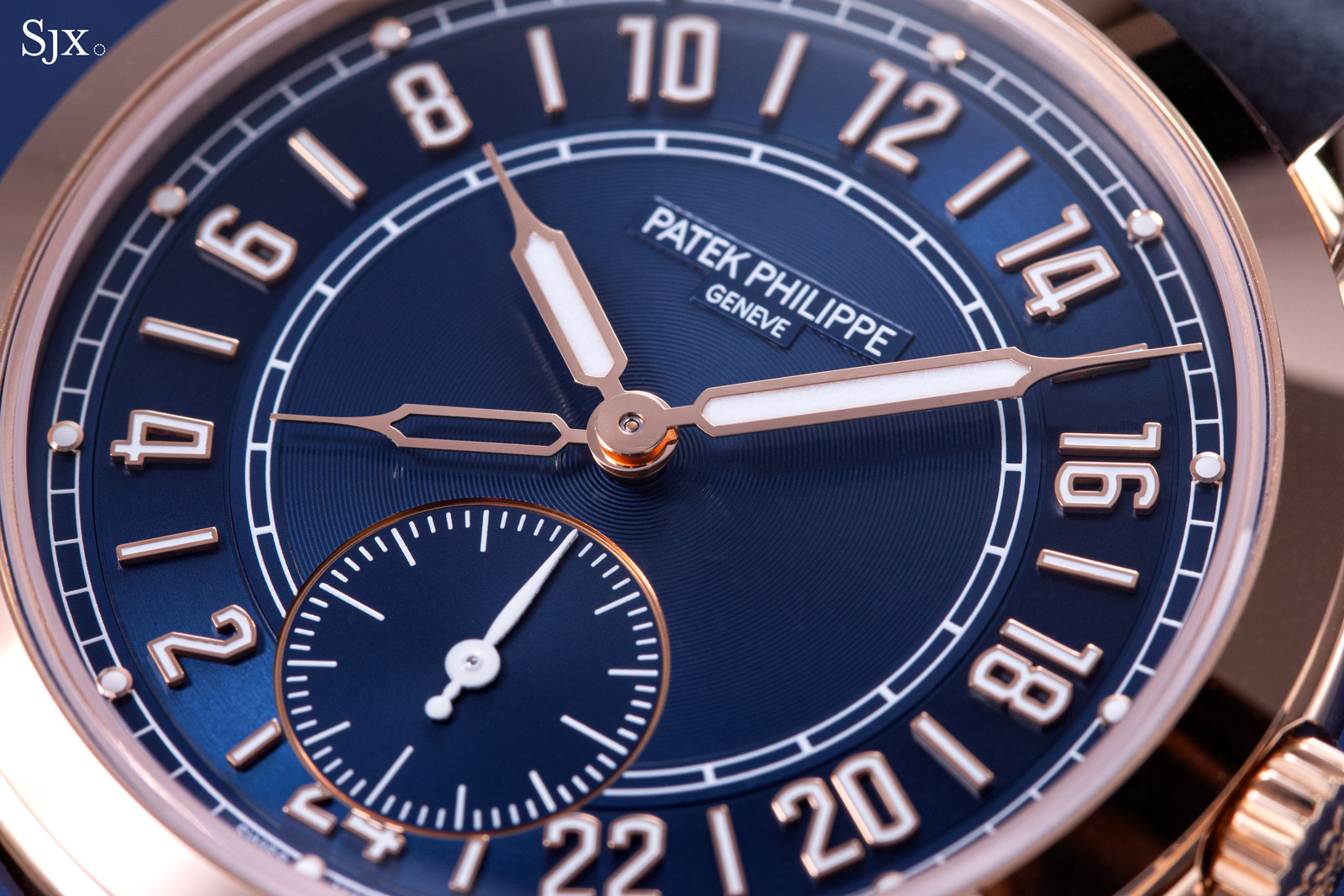
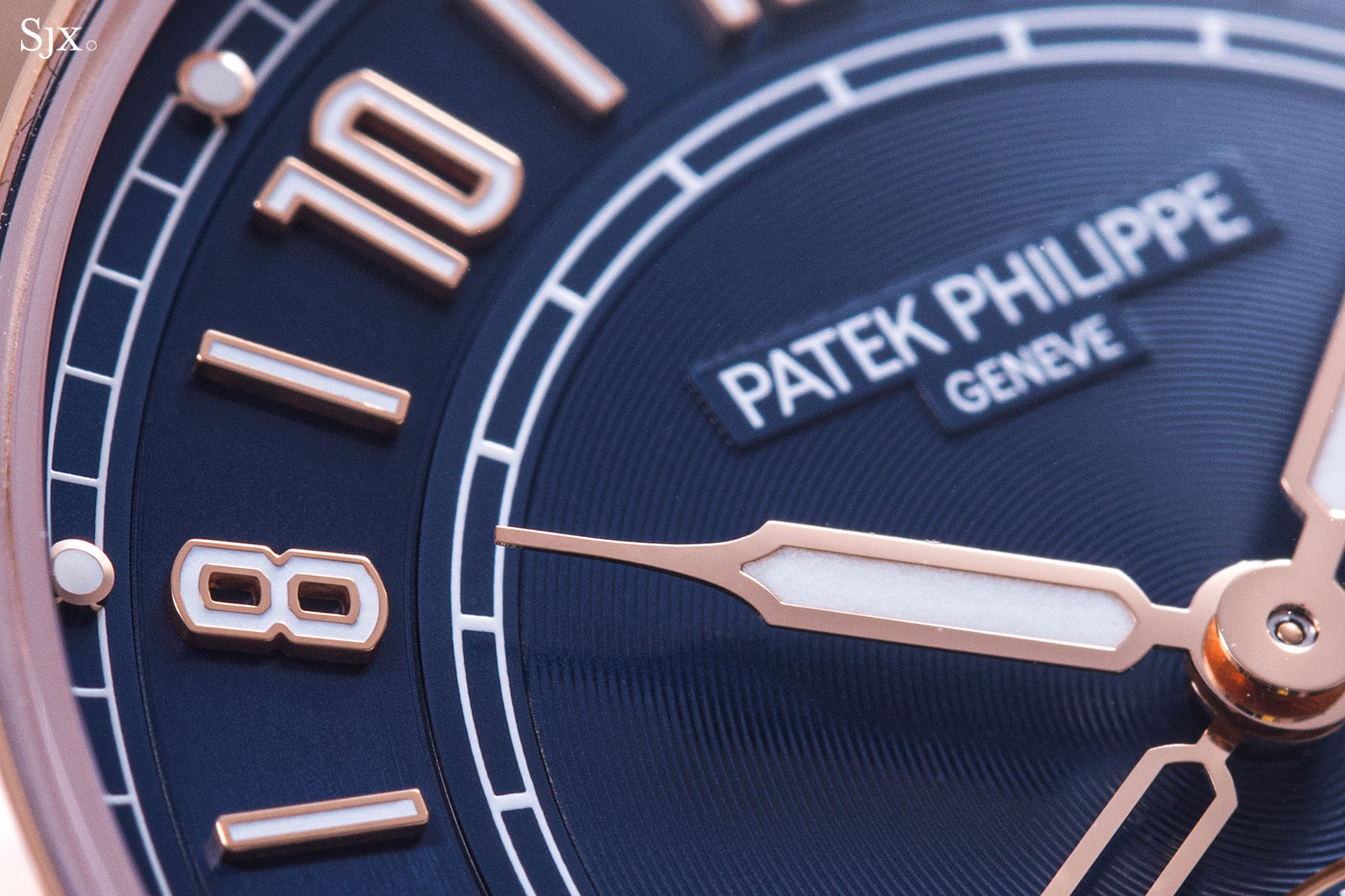
Like the dial, the case design is vintage inspired, but from another period altogether. The designers of the ref. 5224R nonetheless managed to harmoniously blend the disparate sources of inspiration for the dial and case, so everything works well together.
The case design and extra-large diameter are based on the ref. 2512, a one-off wristwatch made in 1955 that also inspired the Calatrava Weekly Calendar ref. 5212A of 2019. As a result, the case of the ref. 5224R is typical of mid-century design, with the deeply fluted edges along the lugs that are common amongst designs of that period.
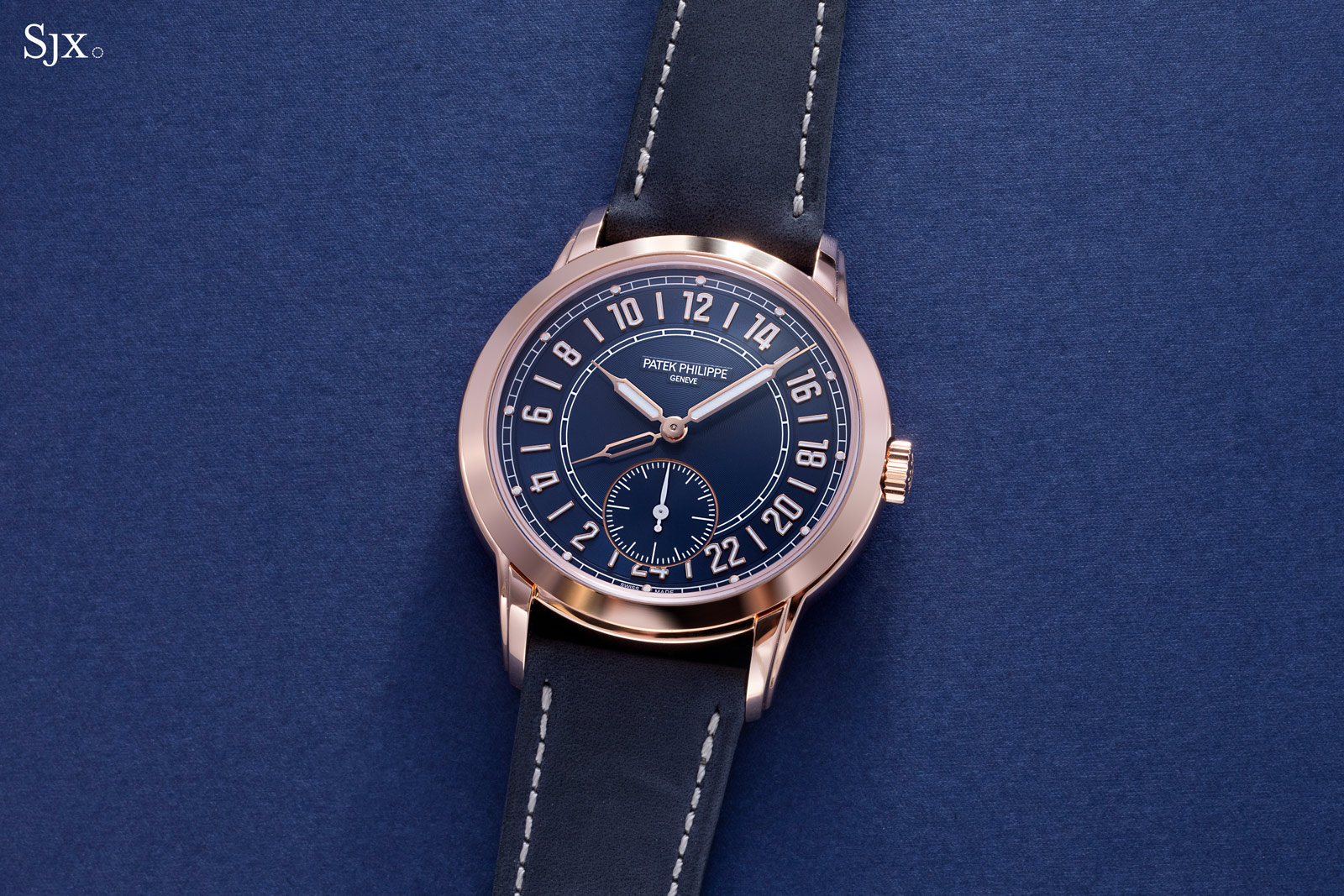
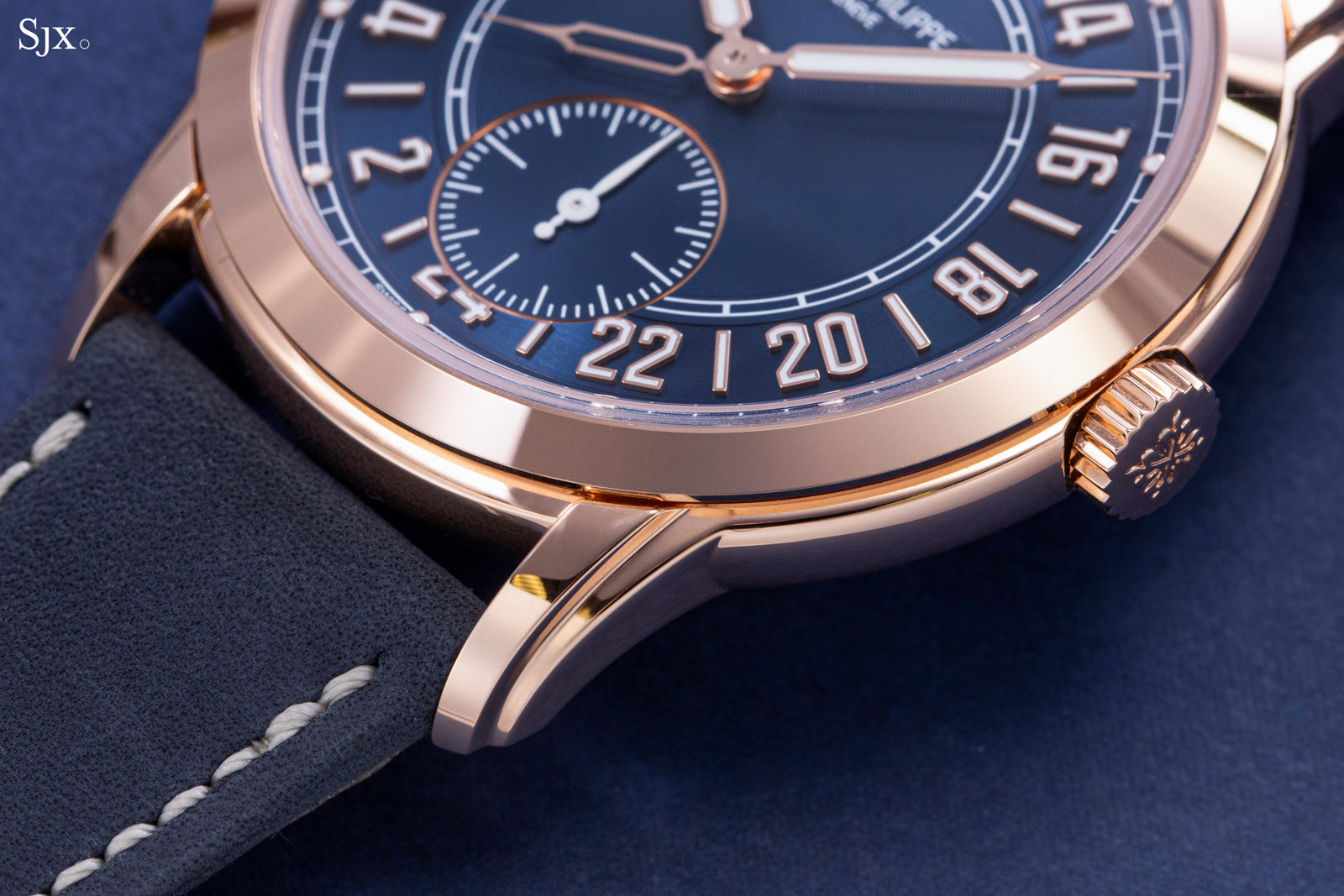
The other key element of the case is its thinness. It is 9.85 mm high, putting it in-between Patek Philippe complications that are usually 10 mm or taller and time-only Calatrava models that are 8 mm or so.
But the ref. 5224R feels unusually thin because of the large case, which gives it elegant proportions. In fact, the proportions of the case are atypical for the brand, since its large watches are usually complications and thick.
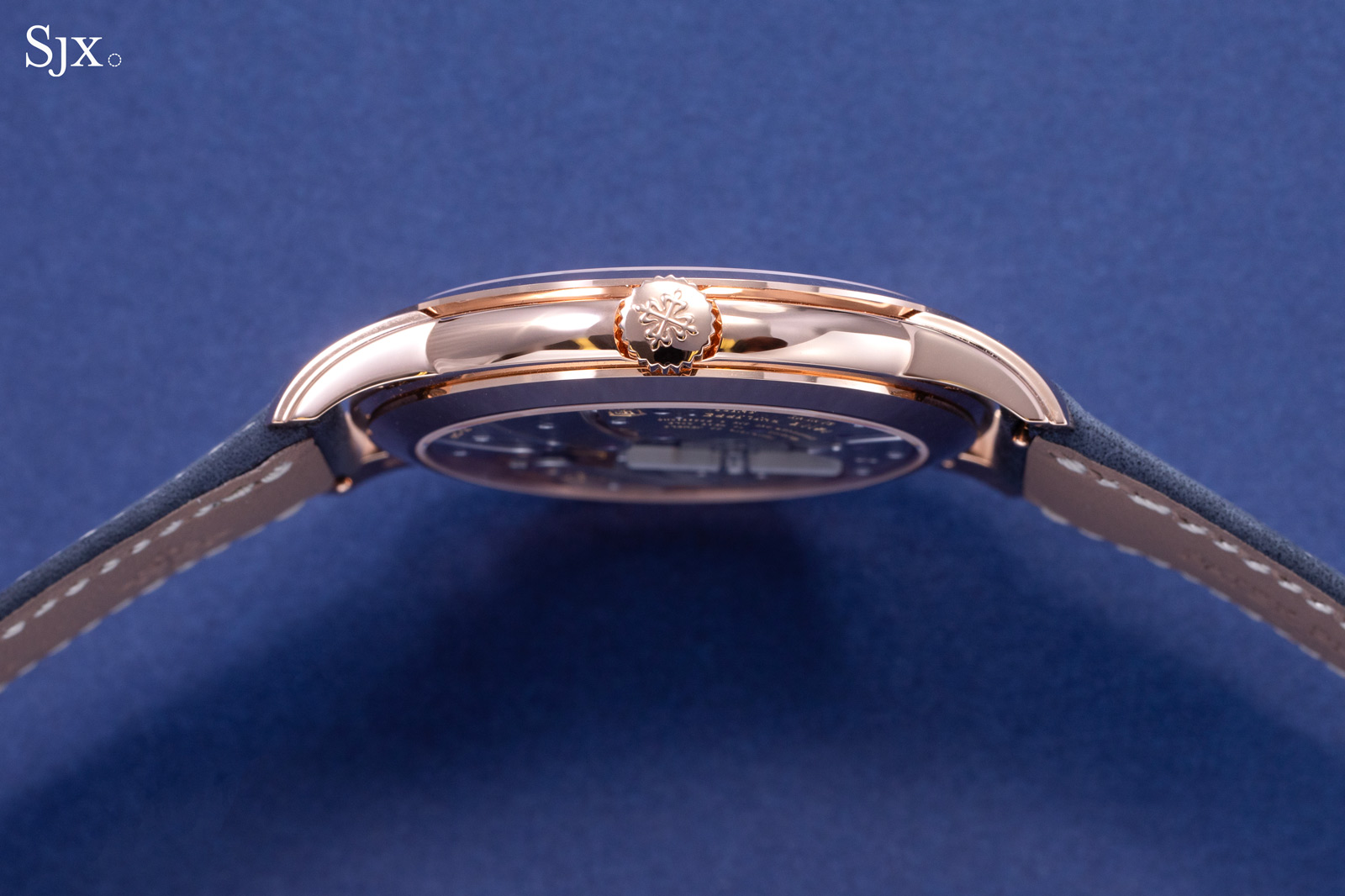
A new(ish) calibre
The view from the back is a good one. Not only is the cal. 31-260 PS FUH 24H one of Patek Philippe’s higher-end movements, it is also large enough that is fits the case well. It’s basically the same base movement found in the ref. 5236P linear perpetual calendar but without the calendar module.
The cal. 31-260 is the latest self-winding movement developed by Patek Philippe. Its basic architecture comes from the first-generation cal. 31-260 found in the ref. 5235 annual calendar, but the calibre found in the ref. 5224R and ref. 5236P has been improved and refined significantly, including with a higher frequency balance.
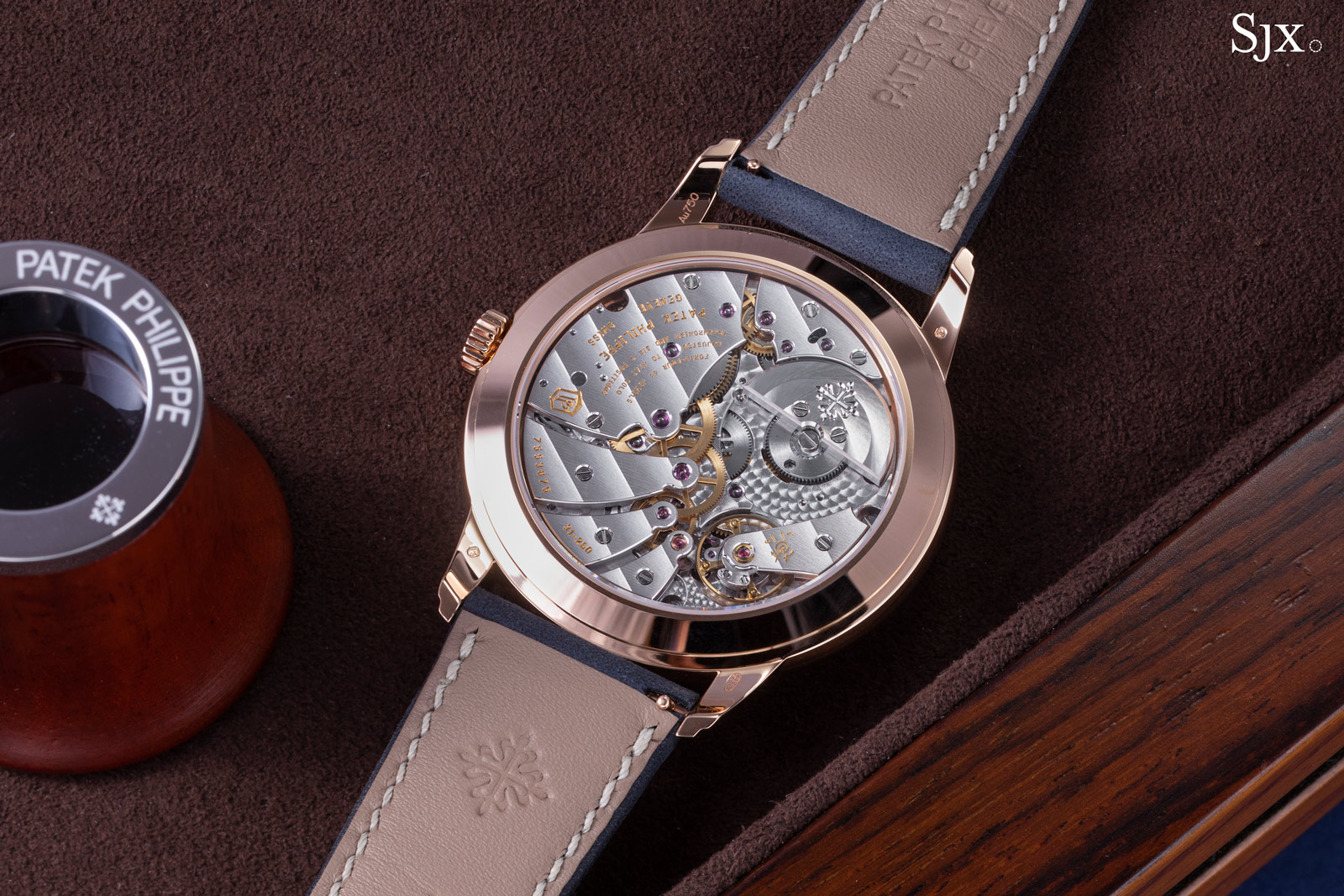
And like all current Patek Philippe movements, the cal. 31-260 incorporates innovations that are geared towards efficiency and functionality. Amongst them are the silicon hairspring, LIGA wheels to eliminate play, as well as a pair of patents relating to the Travel Time mechanism that reduces backlash and misalignment.
We explained the features and details of the movement in our ref. 5236P review, but put simply, the ref. 31-260 is probably the best self-winding movement Patek Philippe currently produces because of its aesthetics, construction, size, and features.
As an aside, the cal. 31-260’s hand-wind counterpart is the cal. 30-255 found in the Calatrava ref. 6119, which is the newest manual-wind movement developed by Patek Philippe. Unsurprisingly, both share similar vital stats, including a wide diameter and long mainsprings (the cal. 31-260 has one barrel while the cal. 30-255 has two), reflecting the brand’s current approach to movement construction.
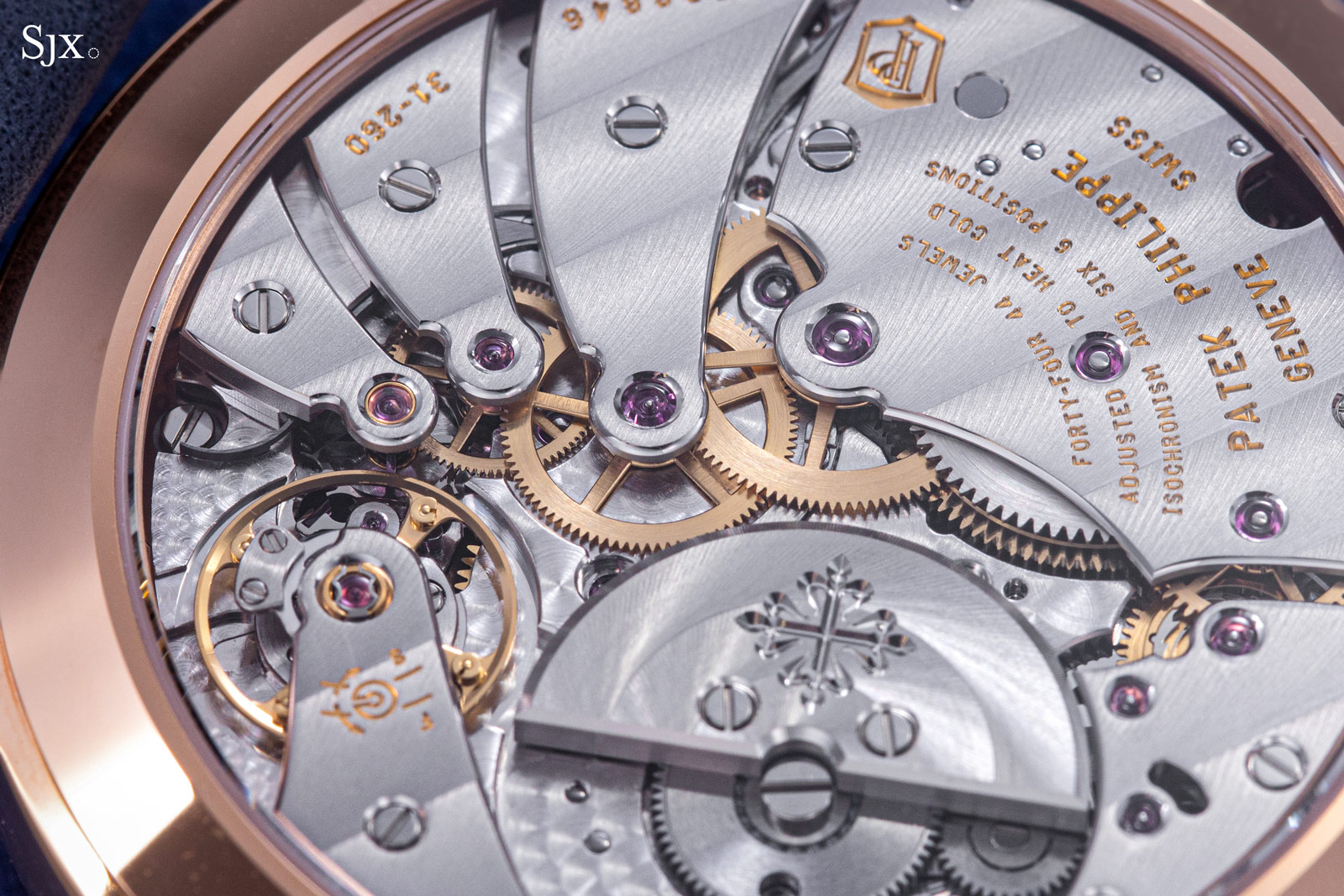
The separate finger bridges for the going train are amongst the design upgrades for the second-generation cal. 31-260
Like all of Patek Philippe’s latest-generation movements, the cal. 31-260 has been designed to be finished better (and probably more efficiently). The result is an appealing decor that has enough hand-applied touches to be amongst the best in industrial haute horlogerie. The bridges, for instance, have rounded, polished bevelling that indicates they were given a finishing touch by a handheld tool. The same goes for the countersinks and chamfered slots in the screws.
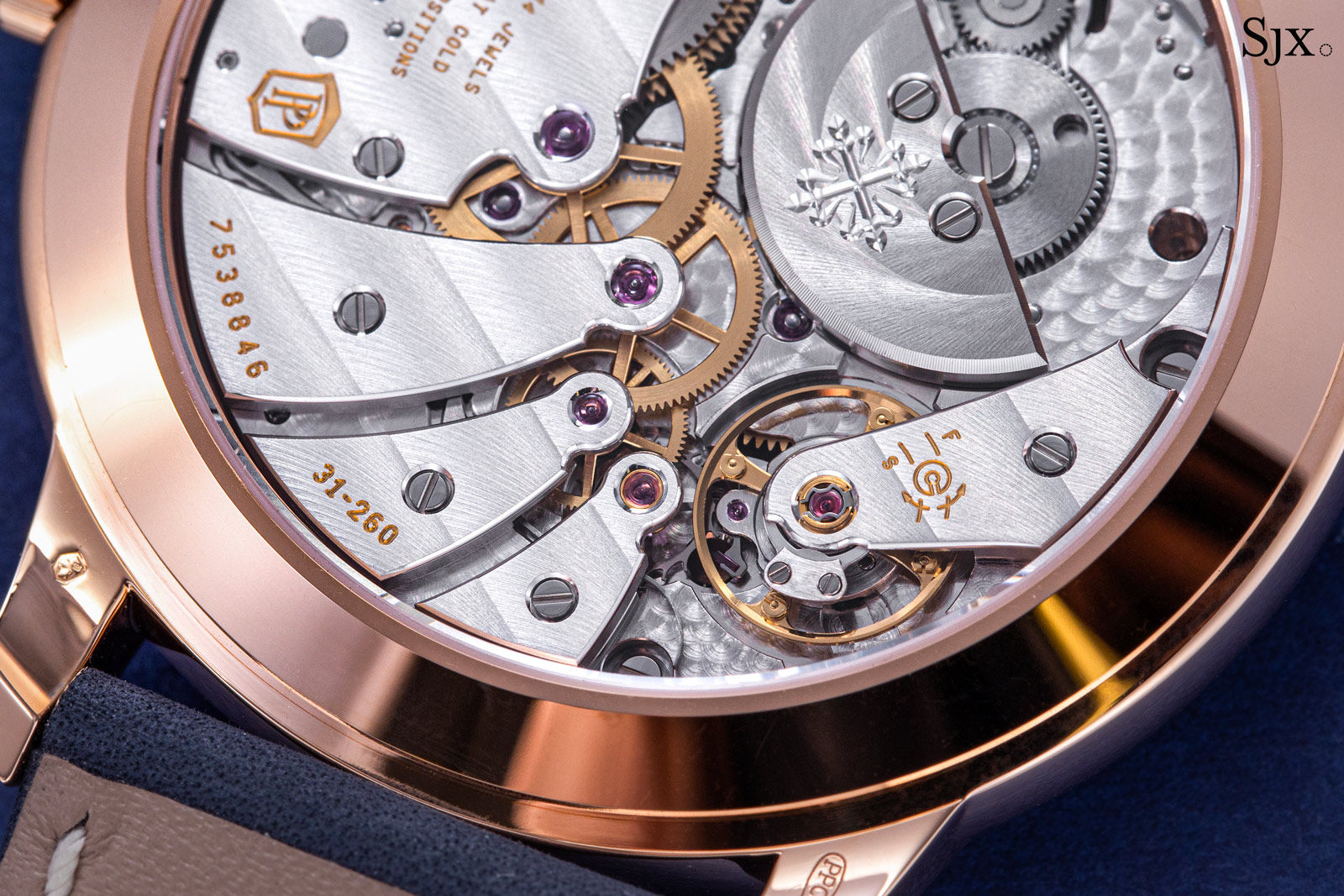
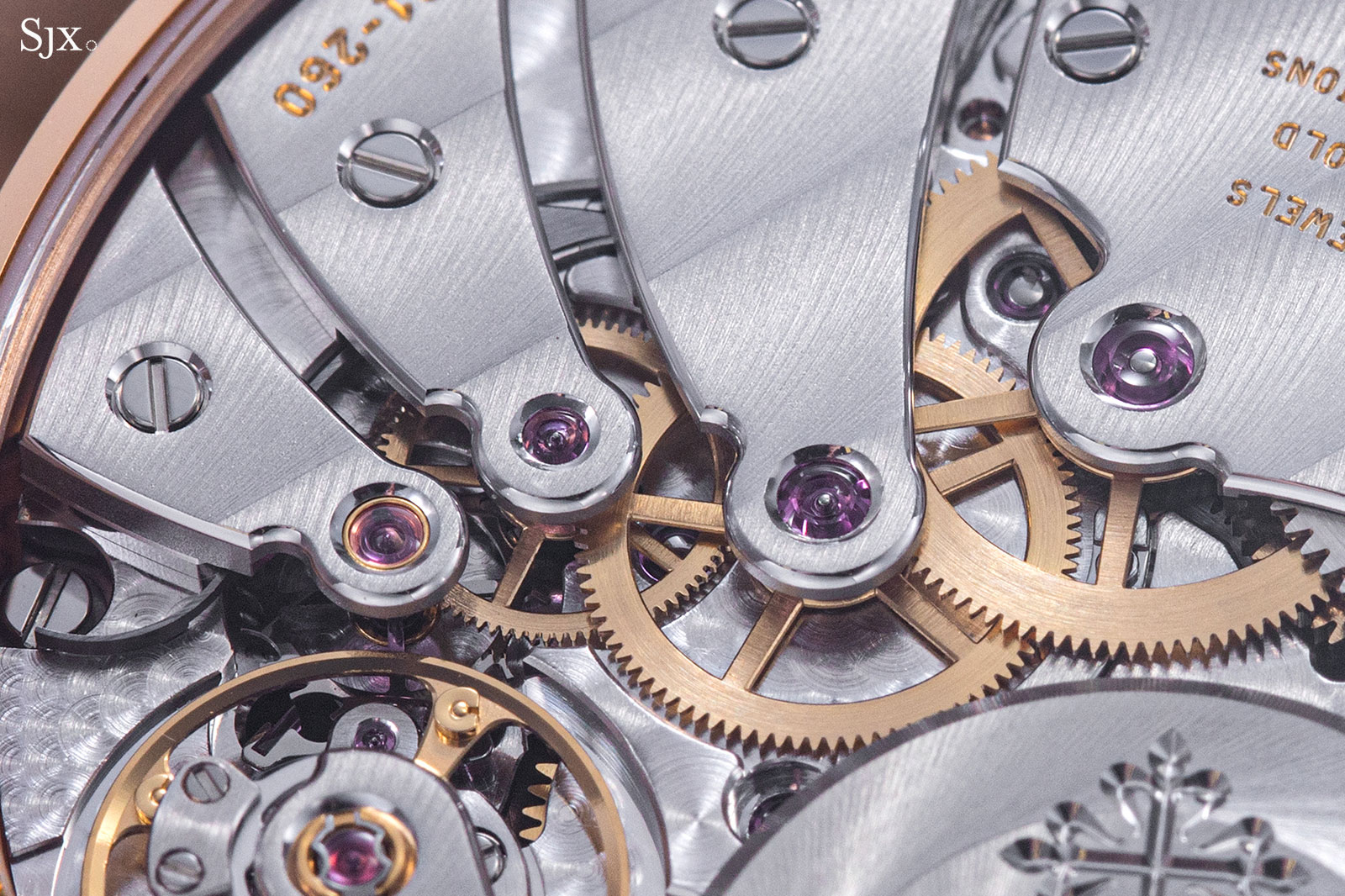
The wheels have chamfered spokes though they appear to be stamped
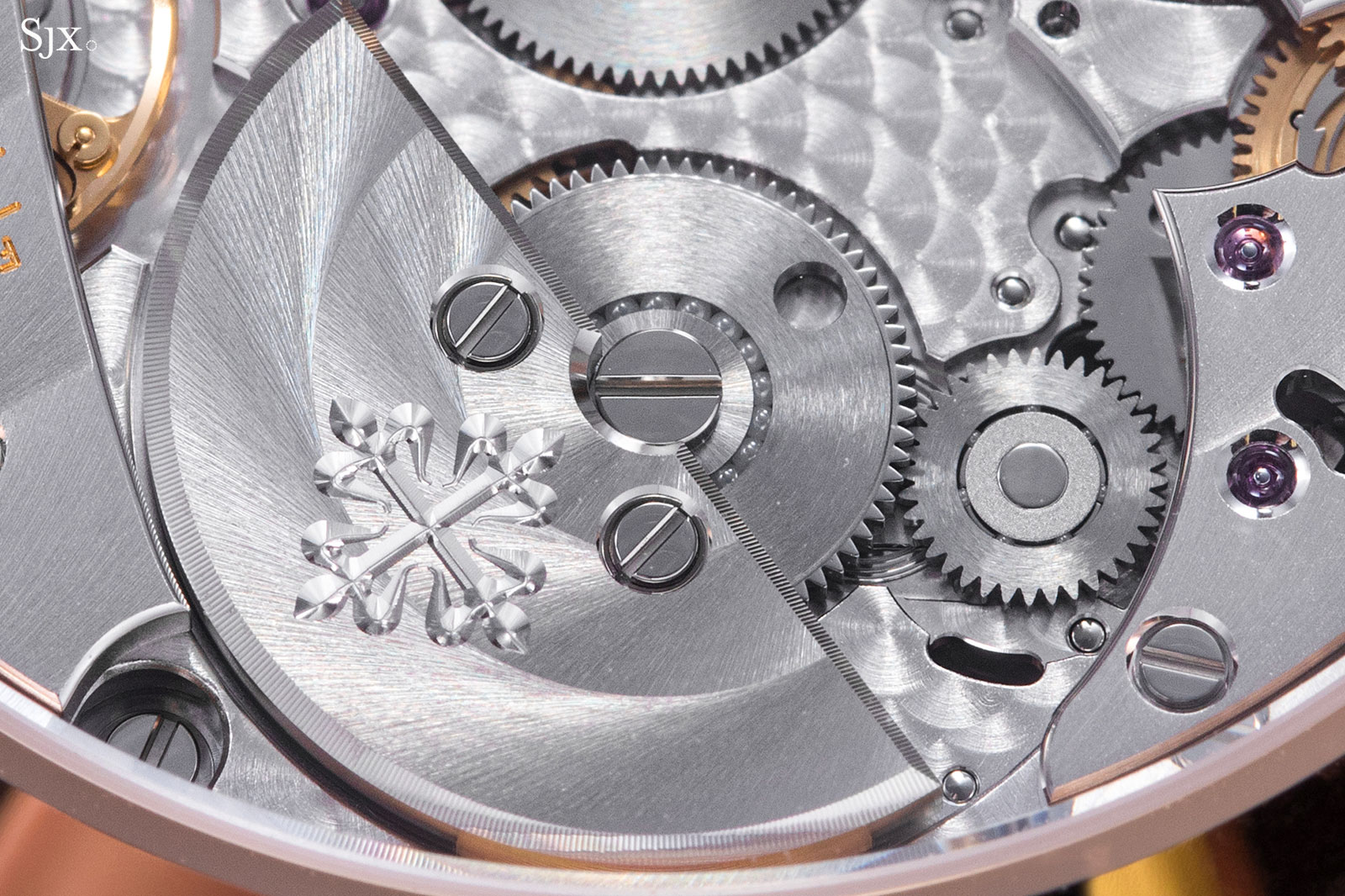
The bevelled on the edges of the rotor has the telltale marks from CNC milling, though this is likely a necessity due to the fact that the rotor is platinum
Concluding thoughts
I like the ref. 5224R. The design, execution, and feel on the wrist make it appealing. The combination of rose gold and blue might be a bit too much, but I could live with it. And yes I do wish it were priced better – but then it would not be a Patek Philippe. And when variants of this are introduced in the future, as they will surely be, it might get even more appealing.
Key facts and price
Patek Philippe Calatrava 24-Hour Display Travel Time
Ref. 5224R-001
Diameter: 42 mm
Height: 9.85 mm
Material: Rose gold
Crystal: Sapphire
Water resistance: 30 m
Movement: Cal. 31-260 PS FUH 24H
Functions: 24-hour display, minutes, seconds, and second time zone
Frequency: 28,800 beats per hour (4 Hz)
Winding: Automatic
Power reserve: 48 hours
Strap: Calfskin with gold pin buckle
Availability: Now at Patek Philippe boutiques and retailers
Price: US$57,370; CHF48,500; or 76,400 Singapore dollars
For more, visit Patek.com.
Correction July 12, 2024: The cal. 31-260 has a single mainspring and not double barrels as stated in an earlier version of the article.
Back to top.






